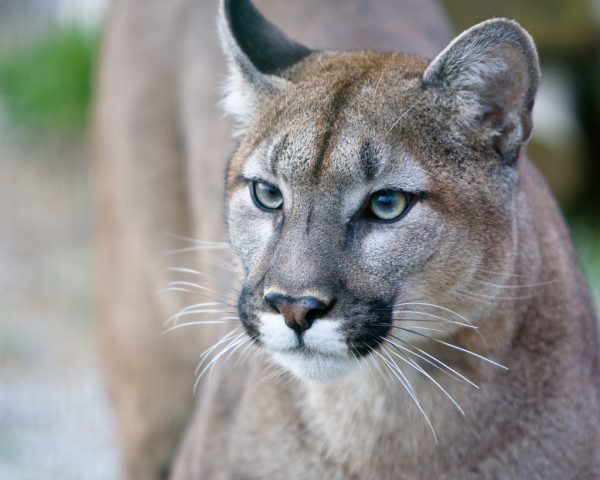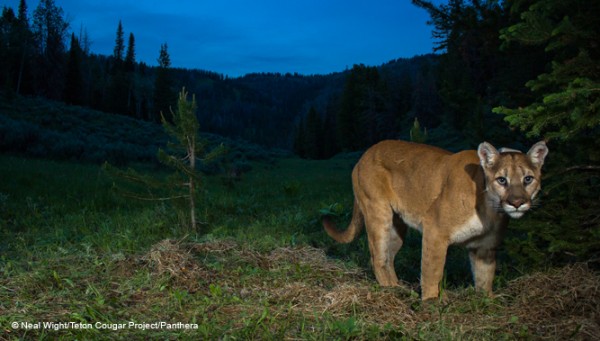
For decades, the cougar (Puma concolor) was thought to be a solitary predator, only engaging with other members of their species to mate or fight. But a new study about one of America’s most iconic big cats, also known as puma or mountain lion, puts that thinking to rest as new research shows that cougars build a rich, hierarchical society based on sharing food.
For more than 60 years of intensive research..we have said [cougars] are solitary, robotic killing machines,” says Mark Elbroch, lead scientist for the Puma Program at Panthera, the global wild cat conservation organization. “Instead, what we have unveiled is a secretive animal with a complex social system built on reciprocity. That flies in the face of everything we ever thought about this animal.,” he adds.
Cougars Caught on Camera

Elbroch’s team’s discovery was published in Scientific Advances this month. For years, he and other researchers caught glimpses of puma crossing paths, but they couldn’t see or understand their interactions. This study was as much a matter of technology advances as it was pure patience.
When Elbroch, a National Geographic conservation grantee, installed a network of camera traps across close to 900 miles of the Greater Yellowstone Ecosystem, he had plans to catch mountain lions in the course of their daily lives.
At first, the scientist wasn’t looking for signs of cougar society, but wanted to learn what the cats are eating. Then he would be able to better estimate their caloric intake and impact on the ecosystem. The camera traps answered this question showing that the highest diversity of scavengers ever recorded on Earth exists at cougar kill sites.
An Amazing Discovery
Then Elbroch discovered something amazing while reviewing camera-trap footage. An adult female cat approaching the carcass of an elk another female cougar had killed.
The two cats hissed and struck postures at one another. But then, the kill site’s cougar let the new visitor share her meal. This generous act was not just a an unlikely occurrence. The two cougars remained in each other’s company or a full day and a half. Genetic data showed the two cats were not related to one another.
Elbroch’s camera had captured the first cougar friendship. ” It just sort of shattered everything we thought we had learned about the species,” he says. ” I remember throwing my hands up in the air.”
As Elbroch continued to study the camera-trap footage he realized what he had witnessed was not as uncommon as he thought. Between 2012 and 2015, the cameras recorded 118 interactions between two cougars. And 60% of the interactions were at kill sites with many doing the meal-sharing he had seen before. Elbroch repeatedly saw cougars “give” other cougars access to their kills.

Mapping Cougar Relationships
The data the research team collected not only exposed these relationships on the footage but also helped the team draw maps of cougar relationships. They learned which cats were hanging out with one another the most often and who visited whom. The tangle of interconnected nodes allow the team to mathematically quantify how interconnected any one cougar is within the social group.
This data not only showed that cougar society existed, but that it was hierarchical. The social groups boundaries mapped closely to the territorial ranges of individual males. Female cats with ranges overlapping the same male’s range were more likely to socially interact than if their ranges didn’t share the same male. The male cougars are like a governor of a territory.
“Lots of folks have intuitively understood that males must be important to the social organization of mountain lions, [but] no one really knew how,” says Elbroch. “What’s cool is that we’ve actually done fancy math and statistical analysis very clearly why males are important in the social organization of mountain lions.”

how this impacts hunting
It is unclear how trophy hunting of cougars might affect cougar society. No hunters killed any of the cougars in Elbroch’s study.
Elbroch hypothesized, that removing a male from a cougar population may lead to social upheaval. This new information may change how wildlife agencies approach management of the species.
“If it is creating social chaos, what are we going to do?” says Elbroch. “Do we allow trophy hunting to continue? Do we adopt new strategies?”